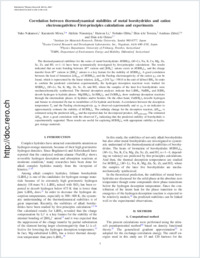Correlation between thermodynamical stabilities of metal borohydrides and cation electronegativites: First-principles calculations and experiments
- Nakamori, Yuko Institute for Materials Research, Tohoku University, Sendai, Japan
- Miwa, Kazutoshi Toyota Central Research and Development Laboratories, Nagakute, Aichi, Japan
- Ninomiya, Akihito Institute for Materials Research, Tohoku University, Sendai, Japan
- Li, Haiwen Institute for Materials Research, Tohoku University, Sendai, Japan
- Ohba, Nobuko Toyota Central Research and Development Laboratories, Nagakute, Aichi, Japan
- Towata, Shin-ichi Toyota Central Research and Development Laboratories, Nagakute, Aichi, Japan
- Züttel, Andreas Physics Department, University of Fribourg, Switzerland - EMPA, Department of Environment, Energy and Mobility, Dübendorf, Switzerland
- Orimo, Shin-ichi Institute for Materials Research, Tohoku University, Sendai, Japan
-
28.07.2006
Published in:
- Physical Review B. - 2006, vol. 74, p. 045126
English
The thermodynamical stabilities for the series of metal borohydrides M(BH₄)n (M=Li, Na, K, Cu, Mg, Zn, Sc, Zr, and Hf; n=1–4) have been systematically investigated by first-principles calculations. The results indicated that an ionic bonding between Mⁿ⁺ cations and [BH₄]⁻ anions exists in M(BH₄)n, and the charge transfer from Mⁿ⁺ cations to [BH₄]⁻ anions is a key feature for the stability of M(BH₄)n. A good correlation between the heat of formation ΔHboro of M(BH₄)n and the Pauling electronegativity of the cation ϰP can be found, which is represented by the linear relation, ΔHboro=248.7ϰP–390.8 in the unit of kJ/mol BH₄. In order to confirm the predicted correlation experimentally, the hydrogen desorption reactions were studied for M(BH₄)n (M=Li, Na, K, Mg, Zn, Sc, Zr, and Hf), where the samples of the later five borohydrides were mechanochemically synthesized. The thermal desorption analyses indicate that LiBH₄, NaBH₄, and KBH₄ desorb hydrogen to hydride phases. Mg(BH₄)₂, Sc(BH₄)₃, and Zr(BH₄)₄ show multistep desorption reactions through the intermediate phases of hydrides and/or borides. On the other hand, Zn(BH₄)₂ desorbs hydrogen and borane to elemental Zn due to instabilities of Zn hydride and boride. A correlation between the desorption temperature Td and the Pauling electronegativity ϰP is observed experimentally and so ϰP is an indicator to approximately estimate the stability of M(BH₄)n. The enthalpy change for the desorption reaction, ΔHdes, is estimated using the predicted ΔHboro and the reported data for decomposed product, ΔHhyd/boride. The estimated ΔHdes show a good correlation with the observed Td, indicating that the predicted stability of borohydride is experimentally supported. These results are useful for exploring M(BH₄)n with appropriate stability as hydrogen storage materials.
- Faculty
- Faculté des sciences et de médecine
- Department
- Département de Physique
- Language
-
- English
- Classification
- Physics
- License
-
License undefined
- Identifiers
-
- RERO DOC 5983
- DOI 10.1103/PhysRevB.74.045126
- Persistent URL
- https://folia.unifr.ch/unifr/documents/299997
Statistics
Document views: 195
File downloads:
- pdf: 267
